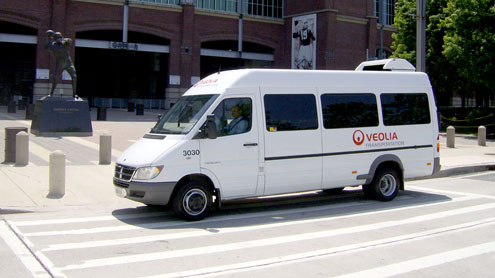
Five key points ease the struggle with increasing demand, rising costs and declining revenues\
By Ron Brooks

I recently attended the American Public Transportation Association (APTA) Legislative Seminar in Washington, D.C. During the APTA Access Committee meeting I had the opportunity to participate in a very thought-provoking discussion on the challenges facing paratransit and how the transit industry will need to respond to ensure paratransit continues to be available.
Specifically, a U.S. Department of Transportation proposed rule would change the requirements to serve customers with non-standard mobility devices and passengers needing additional assistance to use paratransit. Our discussion primarily focused on how the industry will need to respond to the realities of an aging population, ever-increasing demand for paratransit and the increasing cost for the service — all of which is forcing the transit industry to rethink its entire approach for delivering paratransit service.
Five trends have recently surfaced that are having an impact on the efficient and effective delivery of paratransit service. These trends will likely continue and sharpen as we struggle with the clashing trends of increasing demand, rising costs and declining revenues.

Stricter eligibility standards
Whether an agency delivers paratransit service in a sedan, van, dedicated vehicle or taxi, it is more costly than general bus or rail service. This fact, coupled with the increasing level of accessibility within most transit systems, means most seniors and people with disabilities can expect to use conventional transit services whenever possible.
In the past people with disabilities could apply for and receive paratransit services based on a paper application. Today most paratransit systems are requiring some form of written application with an in-person assessment if the paper form is inconclusive. In addition, many transit agencies are beginning to offer training to seniors and people with disabilities on how to use conventional bus and rail systems effectively.
Smaller vehicles
In the past paratransit services utilized large vans and minibuses, but currently more agencies are turning to smaller vehicles such as taxicabs, sedans and minivans, while using larger vans and minibuses only as trip demand for specific locations warrants. Evidence of this trend is the increasing emphasis on taxicabs and the launch of the MV-1—a smaller accessible vehicle designed to operate in either taxi or paratransit fleets.
Increased use of technologies
Not surprisingly technology is playing an even greater role in the delivery of paratransit. Larger transit systems are beginning to implement online trip reservations, IVR systems to notify riders of scheduled pick-up times and vehicle locations, smart card technology for payment of fares and a range of new software products for scheduling, dispatching and monitoring service. These tools are not solely about customer service, nor are they only available for larger systems. Rather, they are robust enough to improve system productivity, reduce travel times, reduce the number of staff required to deliver the same amount of service, and bottom line: decrease the cost of service.
Service cost increases
The challenging economy is already causing transit agencies to increase their focus on the cost of service. With the increasing demand for paratransit services primarily coming from the aging population, the cost effectiveness grows ever more important.
The result of this emphasis on cost is that publicly operated systems are exploring the potential of privatizing service, while privately operated systems are seeking contractors who can do more for less. This is not necessarily a race to the bottom. In fact the downward price pressure is actually creating an environment in which agencies and firms are being more innovative with their approach to delivering service. This is a very positive development as more agencies and firms are willing to deploy alternative service models and technology firms to reduce cost.
Increased focus on integration
The pressure to manage paratransit cost and improve the level of accessibility within conventional bus and rail services is prompting transit agencies to use paratransit services to feed riders into rail and bus networks. This trend will allow both systems to serve more people, which will lead to further service improvements for seniors, people with disabilities and perhaps other riders who need or want public transportation to complete the first or last miles of their trips.
While I believe these trends are posing significant challenges to our current approaches for operating paratransit service, I believe the net impacts of better integration with conventional fixed-route service, more technology, smaller vehicles, and more stringent eligibility requirements will be positive. I’m looking forward to the shape this new insight within the paratransit industry takes in the near future. BR
Ron Brooks serves as Vice President, Paratransit & IntelliRide Development, Veolia Transportation, Lombard, IL.

Hi Ron,
Thanks so much for your insights on where the industry is headed!
My company works on apps for accessible taxi companies, so I’ve spoken to a lot of people with disabilities about how technology can increase their freedom of mobility.
I’ve also thought a lot about multi-model transportation networks with fixed route and on-demand modes—but more to improve public transportation between sparsely populated suburbs. Doing so is really important to make jobs accessible (I actually wrote an article about it here: http://fleetbit.com/blog/hello-world/).
It seems to me like creating integrated paratransit networks and providing private car alternatives in the suburbs and are pretty similar tasks.
Do you think that the two problems might have one shared [tech-heavy, public-private, integrated] solution?
Thanks again for your thoughts—
Krista
Thanks for your comments Ron. I ‘d like to add another trend…teaching people, who currently use paratranist service, to use fixed route for some or all of their trips. supporting.
Thanks for letting me clarify my comment – travel training is a positive trend that can relieve some of the burden of the higher costs of paratransit service.